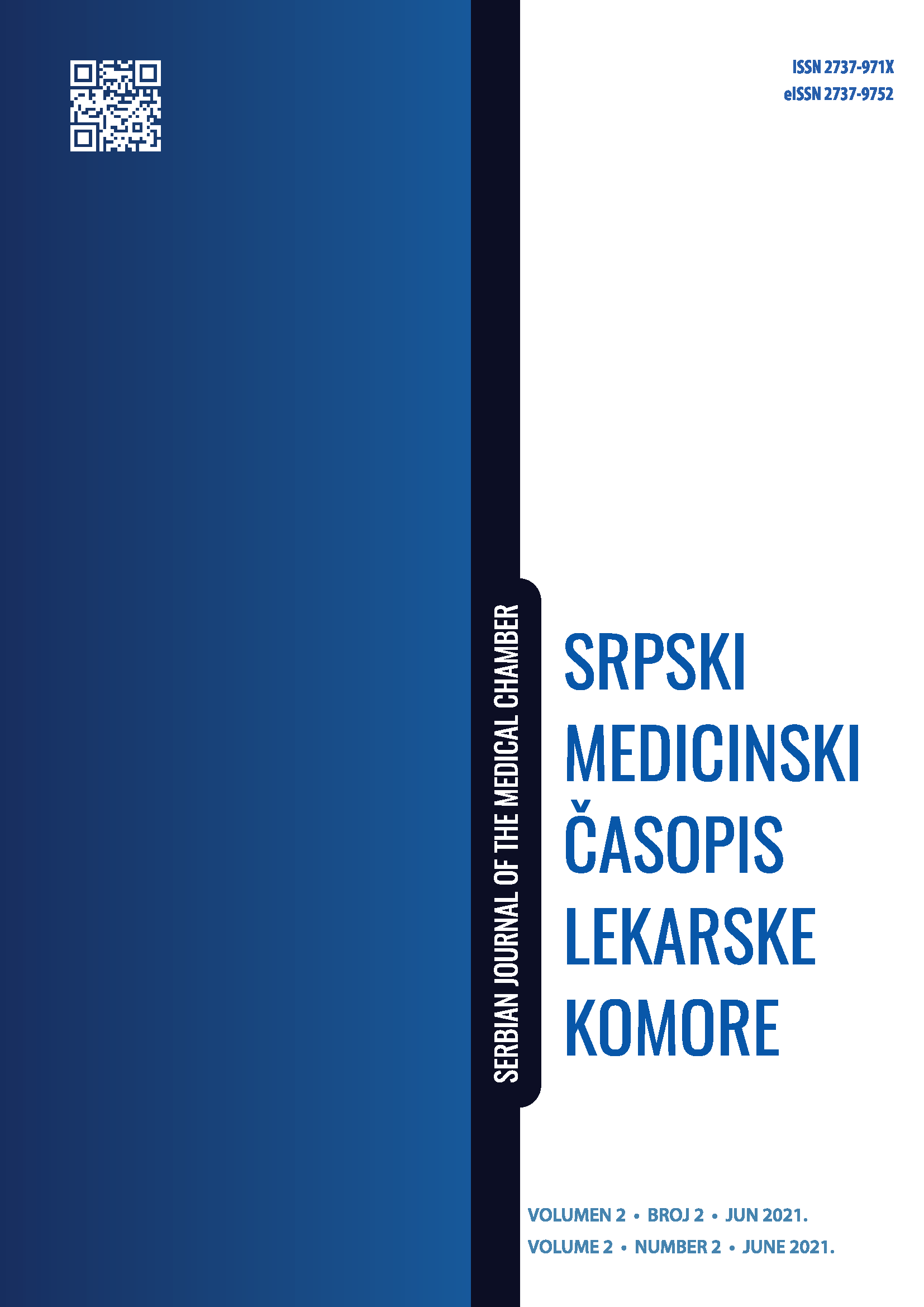Uticaj antigljivične profilakse na pojavu gljivičnih infekcija kod bolesnika u programu alogene transplantacije
Sažetak
Uvod/Cilj: Bolesnici sa hematološkim malignitetima kao što su akutna mijeloidna leukemija i akutna limfoblastna leukemija (AML/ALL), mijelodisplastični sindrom (MDS) i oni koji su podvrgnuti alogenoj transplantaciji matičnih ćelija (allo SCT) su u najvećem riziku od nastanka invazivnih gljivičnih infekcija (IFI). Najčešći među uzročnicima su Candida spp. i Aspergillus spp. Među strategijama za prevenciju nastanka IFI je blagovremena i adekvatna primena antigljivične profilakse koju preporučuje NCCN (National Comprehensive Cancer Network). Cilj istraživanja bila je analiza pojave IFI kod ovih pacijenata, kao i uticaj i značaj pravovremene antigljivične profilakse na njihovo nastajanje.
Metode: U retrospektivnoj studiji ispitivano je 42 bolesnika, prosečne starosti 35 godina, koji su bili u programu allo SCT u periodu od 2017. do 2019. godine i kod kojih je primenjivana antigljivična profilaksa na Klinici za hematologiju, UKCS. Na osnovu informacija dobijenih iz istorija bolesti formirane su baze podataka. Statistička analiza podataka obuhvatala je metode deskriptivne i analitičke statistike i urađena je u SPSS programu.
Rezultati: Klinički manifestnu infekciju u vidu oralne kandidijaze imalo je 19 (45,2%) bolesnika, dok se plućna aspergiloza razvila kod svega 3 (7,1%) bolesnika. Statistički značajna povezanost postojala je između klinički manifestne aspergiloze (7,1%) i prisustva antigena (Galactomannan) kod ovih bolesnika (p<0,001). Utvrđena je i statistički značajna povezanost između klinički manifestne aspergiloze i slabosti kalema [ 2 (66,6%) vs. 1 (33,3%); p=0,016].
Zaključak: Primena adekvatne antigljivične profilakse značajno smanjuje incidencu pojave IFI kod bolesnika u programu allo SCT i na taj način doprinosi smanjenju morbiditeta i mortaliteta.
Ključne reči: antigljivična profilaksa, Mikafungin, Posakonazol, efikasnost profilakse
Reference
2. Pagano L, Caira M, Nosari A et al. Fungal infections in recipients of hematopoietic stem cell transplants: results of the SEIFEM B‐2004 study–Sorveglianza Epidemiologica Infezioni Fungine Nelle Emopatie Maligne. Clin Infect Dis. 2007;45:1161-70.
3. von Eiff M, Roos N, Fegeler W et al. Pulmonary fungal infections in immunocompromised patients: incidence and risk factors. Mycoses. 1994;37:329-35.
4. Lin SJ, Schranz J, Teutsch SM. Aspergillosis case‐fatality rate: systematic review of the literature. Clin Infect Dis. 2001;32:358-66.
5. Ruping, M.J.G.T.Vehreschild, J.J.Cornely, O.A. DRUGS.2008;68(14):1941-1962.
6. Tamura, K., Drew, R. Antifungal prophylaxis in adult hematopoietic stem cell transplant recipients. Drugs Today. 2008; 44(7): 515
7. Vazquez L. Antifungal prophylaxis in immunocompromised patients. Mediterr J Hematol Infect Dis. 2016; 8(1): e2016040.
8. Hicheri Y, Cook G, Cordonnier C. Antifungal prophylaxis in haematology patients: the role of voriconazole. Clin Microbiol Infect. 2012; 18(2): 1–15.
9. Pagano L, Caira M. Risks for infection in patients with myelodysplasia and acute leukemia. Curr Opin Infect Dis. 2012; 25: 612–618.
10. Caira M, Girmenia C, Fadda RM et al. Invasive fungal infections in patients with acute myeloid leukemia and in those submitted to allogeneic hemopoietic stem cell transplant: who is at highest risk? Eur J Haematol. 2008; 81: 242–243.
11. Goodman JL, Winston DJ, Greenfield RA et al. A controlled trial of fluconazole to prevent fungal infections in patients undergoing bone marrow transplantation. N Engl J Med.1992; 326: 845–851.
12. Wingard JR, Carter SL, Walsh TJ et al. Randomized, double‐blind trial of fluconazole versus voriconazole for prevention of invasive fungal infection after allogeneic hematopoietic cell transplantation. Blood. 2010; 116: 5111–5118.
13. Cornely OA, Maertens J, Winston DJ et al. Posaconazole vs. fluconazole or itraconazole prophylaxis in patients with neutropenia. N Engl J Med. 2007; 356: 348–359.
14. Kontoyiannis DP, Marr KA, Park BJ et al. Prospective surveillance for invasive fungal infections in hematopoietic stem cell transplant recipients, 2001e2006: overview of the transplant-associated infection surveillance network (transnet) database. Clin Infect Dis 2010;50: 1091e100.
15. Nucci M, Garnica M, Gloria AB et al. Invasive fungal diseases in haematopoietic cell transplant recipients and in patients with acute myeloid leukaemia or myelodysplasia in Brazil. Clin Microbiol Infect 2013;19:745e51.
16. Girmenia C, Ferretti A, Barberi W. Epidemiology and risk factors for invasive fungal diseases in hematopoietic stem cell transplantation. Curr Opin Hematol 2014;21:459e65.
17. Karthaus M. Prophylaxis and treatment of invasive aspergillosis with voriconazole, posaconazole and caspofungin: review of the literature. Eur J Med Res. 2011;16(4):145–152.
18. Hamdi Akan, Vistasp P. Antia, Michal Kouba et al. Preventing invasive fungal disease in patients with haematological malignancies and the recipients of haematopoietic stem cell transplantation: practical aspects. J Antimicrob Chemother 2013; 68 Suppl 3: iii5 –iii15
19. Vehreschild MJ1, von Bergwelt-Baildon M, Tran L et al. Feasibility and effectiveness of posaconazole prophylaxis in combination with micafungin bridging for patients undergoing allogeneic stem cell transplantation: a 6-yr analysis from the cologne cohort for neutropenic patients. Eur J Haematol. 2014; 93(5): 400-6.
20. Corzo-León DE, Satlin MJ, Soave R et al. Epidemiology and outcomes of invasive fungal infections in allogeneic haematopoietic stem cell transplant recipients in the era of antifungal prophylaxis: a single-centre study with focus on emerging pathogens. Mycoses. 2015 Jun;58(6):325-36.
21. Wohlfarth P, Turki AT, Steinmann J et al. Microbiologic Diagnostic Workup of Acute Respiratory Failure with Pulmonary Infiltrates after Allogeneic Hematopoietic Stem Cell Transplantation: Findings in the Era of Molecular- and Biomarker-Based Assays. Biol Blood Marrow Transplant. 2018 Aug;24(8):1707-1714.

